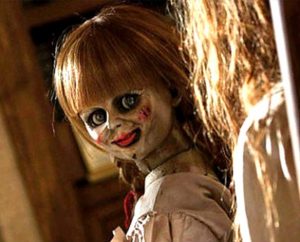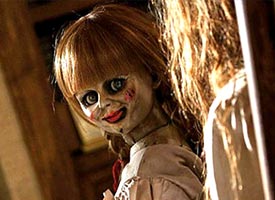(Rated 14A [Canada] and R [MPAA] for intense sequences of disturbing violence and terror; directed by John R. Leonetti; stars Annabelle Wallis, Ward Horton, Tony Amendola, Alfre Woodard; run time: 98 minutes.)
Bad theology, all dolled up
By Ted Giese
“Annabelle” is the follow-up to James Wan’s horror film, “The Conjuring” (2013). This time out, Wan is a producer and not the director; “Annabelle” is directed by Wan’s cinematographer from “The Conjuring,” John R. Leonetti.

Set in 1970, the film’s central young couple, Mia (Annabelle Wallis) and John (Ward Horton), are expecting their first child when they experience the tragedy of their next-door neighbors being brutally murdered — and they, too, are assaulted by the murderers.
One of the murderers is the neighbors’ estranged daughter, who is part of a satanic cult. While barricaded in the baby’s room at Mia and John’s house, the estranged daughter, named Annabelle, commits suicide while holding an antique doll purchased by John for his wife.
What follows is the story of Mia and her family dealing with the ghost of the estranged girl, Annabelle, trapped in the vintage doll. Along the way they engage the help of their Roman Catholic priest, Father Perez (Tony Amendola), and a local bookstore owner (Alfre Woodard), who befriends Mia. It is determined that the doll isn’t haunted by a ghost but rather is controlled by a demon who wants to steal souls. By the end of the film, the doll has changed ownership hands, potentially setting things up for yet another film.
Most people simply avoid these sorts of movies altogether, and in no way is this review a recommendation to run out and see it. However, the film raises questions about the supernatural, particularly about evil within the supernatural. Although “Annabelle” and “The Conjuring” provide answers to supernatural questions concerning death, demons and the nature of evil, do the views expressed by the filmmakers fit with what Christians believe, teach and confess?
As to the question of death, “Annabelle” presents a worldview where, on some level, the dead can remain in the world as ghosts. While this view is described in Scripture (e.g., Matt. 14:26), the Bible doesn’t teach it as the natural state of things after death (Heb. 9:27). Apart from the Biblical teaching that the spirit of the deceased leaves the body (Eccl. 12:7), “Annabelle” doesn’t present a Christian view of death even though it’s set in a Roman Catholic milieu. Truly, the film has more in common with the depiction of spirits within animism popularized by movies like “Ju-on: The Grudge” (2002) or “Ringu: Ring” (1998).
When it comes to demons, “Annabelle” starts hitting a little closer to the biblical mark. In the end, what’s standing behind the doll isn’t a “ghost” but rather a demon. The film is a little vague as to the relationship between the demon and the ghost, but it is clear the demon is the true threat. It’s never clear whether the ghost is controlled by the demon or if the ghost is an illusion created by the demon.
Luther in the Smalcald Articles, while talking about abuses in the Roman Catholic Mass, says that “evil spirits have produced many wicked tricks by appearing as the souls of the departed, and with unspeakable lies and tricks demanded Masses, vigils, pilgrimages and other alms.” In “Annabelle,” the demon demands a soul to devour, but the catch is that the soul can’t be taken; it has to be offered up. Father Perez warns the couple that the devil is a deceiver, the demon will work to deceive them into offering their souls, and that demons are hungry for souls to devour. This echoes what Scripture says when Satan is described as “the deceiver of the whole world” (Rev. 12:9), “a murderer from the beginning” and “the father of lies” (John 8:44) “[prowling] around like a roaring lion, seeking someone to devour” (1 Peter 5:8).
What about evil? How does “Annabelle” tackle this topic? Behind the doll, a deranged, suicidal ghost; behind the ghost, a demon; and behind the demon, evil. Scripturally speaking, demons are described as standing behind idols with people making sacrifices to them (Lev. 17:7, Deut. 32:17, 1 Cor. 10:20). In “Annabelle,” the demon is both evil and demands sacrifice.
The film, however, misrepresents evil when Father Perez says, “Evil is constant. You cannot destroy what was never created.” Scripture teaches that evil is at its core disobedience to God (Gen. 3). Before creation there was nothing in existence that could rebel against God, so there was no evil, and therefore it was not constant from eternity. The Augsburg Confession lays original sin (the origin of evil in man) at the foot of the fall into sin; therefore, it’s not a created thing but a byproduct of disobedience.
While Scripture teaches that evil/sin will be punished eternally in hell, Christians can take comfort that in the new heaven and the new earth, God promises that evil (Zeph. 3:15-17) and the demons will be removed (2 Peter 2:4, Matt. 25:41, Rev. 20:10), and “death will be no more” (Rev. 21:4). These enemies of faith are crushed at the foot of the cross. “Annabelle” is not really interested in any of this. Rather, Father Perez’s line of dialogue fits best into Hollywood’s typical concept of eternal dualism: Good and Evil with their horns locked for eternity, which isn’t biblical.
In reality it is unlikely a Roman Catholic priest would fatalistically say such a thing while dealing with the topic of the demonic. Along with other Christian clergy, it would be more likely for him to quote James 4:7: “Resist the devil, and he will flee from you,” or St. Paul in Romans 12:21: “Do not be overcome by evil, but overcome evil with good.”
“Annabelle” also deals with the topic of suicide. Murder and suicide within the film are ways in which a person sacrifices a soul to the demon. Spoiler ahead! (If you plan to see the film and want to avoid having it spoiled, stop reading here and come back later.)
At the beginning of the movie, Mia and John are in church listening to Father Perez preach on John 15:13: “Greater love has no one than this, that someone lay down his life for his friends.” In his sermon, the priest says that God is happy with our sacrifices for others, and that personal sacrifices make God smile on us. At the end of the film, one of the characters commits suicide to protect Mia and John’s daughter, Lea, from the demon.
The character essentially offers his/her life to spare the lives of others. When this happens, viewers hear Father Perez’s sermon over the scene of the suicide, including the quotation from the Gospel of John and the part about God being happy with our sacrifice and smiling down upon it. This is extraordinarily problematic from a Christian perspective, and it would be difficult to imagine a Christian approving that line of thinking. Ultimately, John 15:13 is Jesus pointing to His coming crucifixion for our salvation, yet in “Annabelle” it is used out of context and twisted into something never intended in Scripture.
Again, Wan and Leonetti have crafted a film with a rather thin veneer of Christianity. As in “The Conjuring,” the theological assertions are unreliable. Add to this the overabundance of uninspired horror-film stock characters executed with marginal acting skill and “Annabelle” ends up falling short of its goal. While it might be frightening to some viewers, it could have been more frightening, which is the general intention of a horror film. Apart from a couple of “jump scares,” “Annabelle” is just not that good. The truly horrifying elements within the film are bad preaching and bad theology.
The Rev. Ted Giese is associate pastor of Mount Olive Lutheran Church, Regina, Saskatchewan, Canada; a contributor to “Reformation Rush Hour” on KFUO-AM Radio, The Canadian Lutheran and Reporter Online; and movie reviewer for the “Issues, Etc.” radio program.
Posted Oct. 9, 2014

